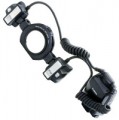LED
Flashes of this type use one or more diodes as a light source. As a rule, LED light is significantly inferior to xenon illumination in terms of light flux intensity, but it can boast high energy efficiency and reliability. LED flashes are mainly used as stationary illumination and are found in macro photography and on-camera versions.
Guide number
The guide number is the main characteristic that describes the power of the light pulse of the flash. It is described as the maximum distance (in metres) at which, at ISO 100 and f/1 lens speed (aperture 1), a flash is able to illuminate an "average" subject sufficiently for a normal exposure; in other words, at what distance from the flash it will be possible to normally shoot the scene at the specified ISO and aperture.
There are formulas by which, knowing the guide number, you can derive the practical shooting distance for each specific value of sensitivity and aperture. The simplest formula used to calculate the distance at ISO 100 is: S=N/f, where S is the distance, N is the guide number, f is the aperture value. For example, for a guide number of 56 and an f/2.8 lens, this distance would be 56/2.8 = 20 m. Increasing or decreasing sensitivity by a factor of 2 would increase or decrease the specified distance by approximately 1.4 times, respectively. If you need to calculate the distance as accurately as possible, you should refer to more detailed formulas that can be found in specialized sources.
Separately, it is worth noting that the leading numbers of flashes, usually, are indicated by manufacturers for specific focal lengths of lenses. This is due to the fact that the shorter the focal length and, accordingly, the wider the viewing angle, the more light is needed to illuminate the scene being shot and the more powerful the flash pulse should b...e (at the same distance). Therefore, when choosing by the guide number, it makes sense to pay attention to the focal length indicated by the manufacturer and select a model with a power reserve — especially since guide numbers are often prescribed for rather “long-range” lenses (with a focal length of about 80-100 mm in equiv. 35 mm).
Rotary head
Possibility to turn the flash head (bulb) to the side.
Shooting with a flash aimed directly at the stage, “head on”, is far from always the best option: in particular, this mode gives sharp unpleasant shadows, and in portrait shooting it leads to the “red-eye” effect. At the same time, by turning the head towards the ceiling, you can get soft diffused light. There are other uses for
swivel heads.
The simplest flash models with this feature can usually only be rotated in the vertical plane. More advanced options include rotation and horizontally. Here we note that the larger the angle, the more opportunities for setting the location of the head gives the flash. Vertically, it usually does not exceed 90°, and in the horizontal plane it can reach a full 360°.
Screen backlight
The flash display (see above) has its own
backlight. Thanks to this function, information on the display will be visible even in complete darkness. Note that the backlight consumes battery power, which accordingly affects battery life.

